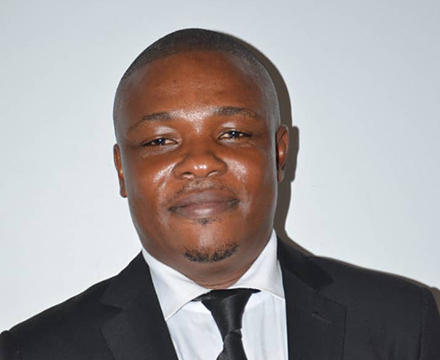By Julie Leibach

When he was barely a teenager, immunologist Ouambo Fotso Herve, Ph.D., saw a future for himself in public health research. His father had just died from cancer, and the best way to honor his memory, Herve thought, was by helping others.
"One of my father's dreams was to see me become a doctor in a research domain," he said. "When I saw how he was suffering, I decided to work in science, with the main objective of finding definitive solutions to eradicating diseases."
After earning dual master's degrees in animal and human physiology and clinical immunology, Herve pursued a Ph.D. in chemical pathology from the University of Buea, in Cameroon. He is now a post-doctoral researcher at the Chantal Biya International Reference Centre (IRCCB). Located in the Cameroonian capital of Yaounde, the center investigates malaria, HIV, tuberculosis, hepatitis, and other infectious diseases of concern in Central Africa.
"We have state-of-the-art equipment, and our researchers are working in collaboration with many others around the world," he said.
Herve is also wrapping up a GloCal Health Fellowship , sponsored by the National Institutes of Health's Fogarty International Center . The program offers interdisciplinary education and training to aspiring global health researchers from University of California campuses and affiliated international sites. Herve's fellowship is based at IRCCB and is associated with the University of California, Los Angeles.
His research examines how exposure to chemicals called per- and polyfluoroalkyl substances (PFAS) affect infants' immune response to hepatitis B vaccination. Sometimes called perflourinated compounds, the chemicals are commonly found in carpets, nonstick cookware, and other consumer products that demand stain-, grease-, or water-resistance. Studies have revealed links between PFAS exposure and various health effects , including altered immune and thyroid function, liver and kidney disease, reproductive and developmental problems, and cancer.
The idea for Herve's study sprang from his doctoral research, which focused on improving vaccines against malaria.
"One of my main observations was that children living in the same region, with the same intensity of malaria transmission but with different environmental conditions, did not present the same responses to a vaccine candidate," Herve recalled.
He wondered: Could something else have influenced the kids' immune reactions? As he dug online for insight, a 2012 paper caught his eye. Led by NIEHS grantee Phillippe Grandjean, M.D., D.M.Sc., the study found that high exposures to PFAS were associated with reduced immune response to tetanus and diphtheria vaccinations in 5- and 7-year-olds.
Herve was curious if conducting a similar study in Cameroon would show comparable results.
Working with maternity wards around the country, he collected blood samples from pregnant women and placental blood samples after they delivered their babies. Once the infants received three doses of hepatitis B vaccination, he gathered blood samples from each child. Herve is now analyzing the results for correlations between PFAS concentrations and measures of vaccine effectiveness.
Building Trust
Recruiting study participants - he has about 110 mother-child pairs - was a hurdle. Few people were familiar with the potential health effects of PFAS exposure, he noticed.
"The healthcare providers are not aware of perfluorinated compounds, and it is also very difficult to convince parents to accept that their babies could be exposed to something that they didn't know anything about," Herve explained.
The experience has inspired him to raise awareness about PFAS and other environmental chemicals through a community engagement campaign, which he will launch once he is ready to share his study results. As Herve sees it, face-to-face conversations with the public are essential to improving public health.
"During conversations is the best time for me to really exchange with patients. They can express what they are feeling," he said.
Once his fellowship is complete, Herve plans to continue studying infectious diseases, drawing on earlier collaborative research experiences.
"When we are talking about human health issues, it is not just a matter of ‘immunologist.' It is not just a matter of ‘physician.' I need to work with people involved in the whole health system," he said.
"The researcher is not just a man who can stay in his laboratory and think that he is going to change the world. It is not possible for him. We need to work together and show that by doing so, we can get better results."


